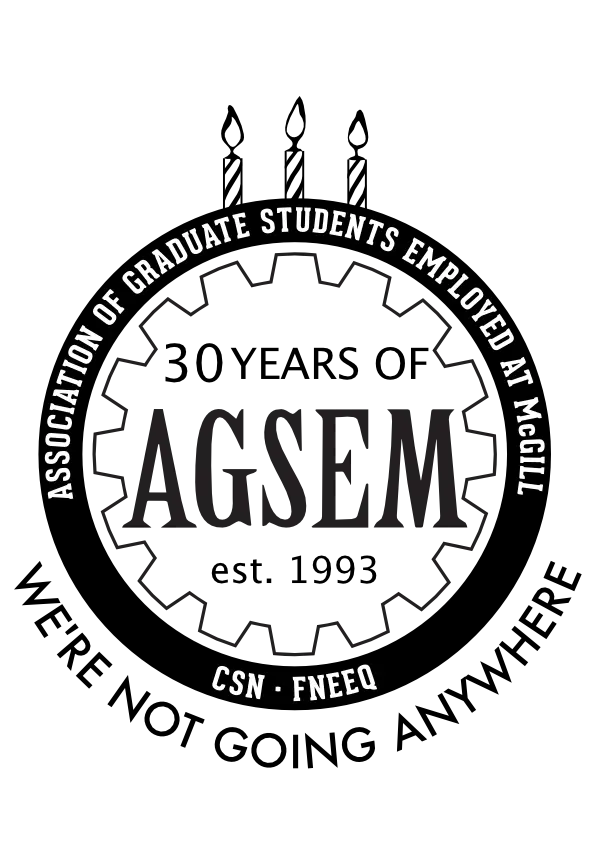Exhibit 4 - AGSEM Expands: Invigilators and Course Lecturers Get Organized (2010–13)
Location of physical exhibit: 7th floor of the Leacock Building, take two right turns from the elevator bank, and the AGSEM bulletin board for History is on the left wall past the administrative offices.
The early 2010s represented a wave of unionization at McGill, with support employees (AMUSE) and research assistants (AMURE) successfully organizing with the Public Service Alliance of Canada (PSAC). While AGSEM had always been intended to represent all graduate students who work at McGill, at the time several employee groups continued to be exempted from the protections of a collective agreement.
In 2010, AGSEM began a campaign to unionize invigilators, who suffered some of the worst working conditions and wages on campus. Invigilators at McGill were accredited as a union in March 2010, after a successful vote (94%) in favour of unionizing. With this vote, over 900 invigilators joined AGSEM as the union’s Unit 2. In March 2013 Invigilators decided to join the Executive Committee structure, Budget and Delegate Council with those of AGSEM Unit 1 (Teaching Assistants). The fight to win a collective agreement for the new unit was a long one, but in October 2013 AGSEM signed a first invigilator contract with McGill. While the contract standardized the invigilator positions, pay remained low due to the binding decision made by the arbitrator assigned to the case.
“How to Complain About the Conditions of Your Job” (n. d.). AGSEM Archives, Vol. 4.1 “Misc. Flyers and Booklets.”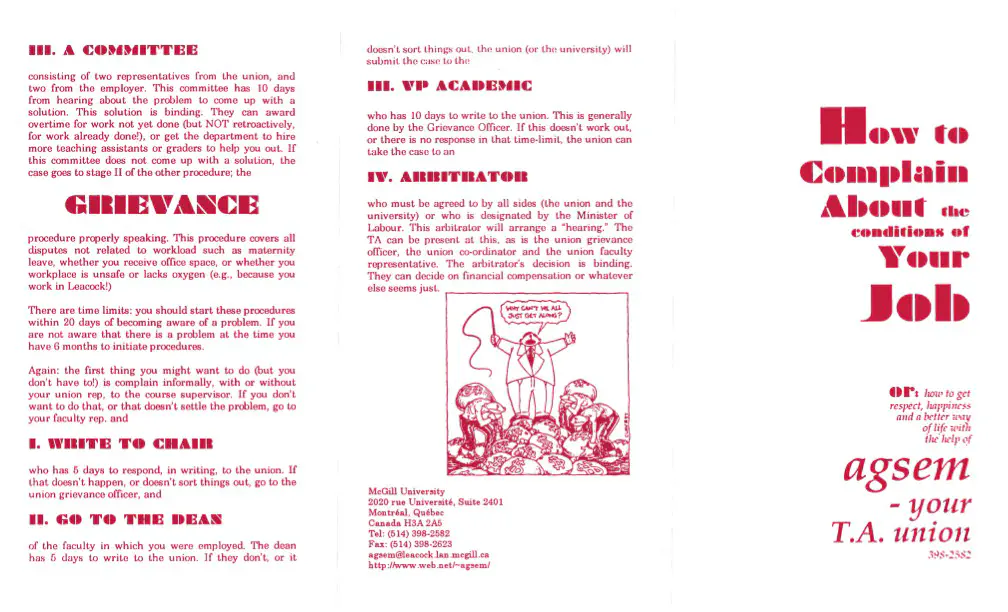

“Credit to Derek Nystrom, who met with me at the AGSEM office, when we were doing the unionization drives and said, ‘OK, how can we help?’ And we came up with the idea of an open letter. And so, Derek, as the representative of MFLAG [McGill Faculty Labour Action Group], coordinated 100 faculty members at McGill to sign this open letter publicly during our unionization drives. And it was published on the front page of the McGill Daily, and that was huge. That changed everything because there had been no sense of full-time faculty being mobilized enough to be pro-labor in that kind of a visible way.”
—Interview with Lilian Radovac, AGSEM President (2005-07).

“Protect yourself.” (2010). AGSEM Archives, Vol. 4.1 “United Against Austerity Posters.”
A year and a half after the drive for invigilators began, AGSEM’s second major unionization campaign was to organize course lecturers into a third unit. After two decades and four failed attempts, AGSEM successfully led the campaign to outright establish a union of McGill course lecturers and instructors in August 2011 by submitting over 50% of the cards to the Labour Board. In the following years, certain tensions developed between teaching assistants and course lecturers within the union, and with the support of CSN, there was an amicable split in 2013, with the course lecturers forming the McGill Course Lecturers and Instructors Union (MCLIU). Since then, AGSEM and MCLIU have continued to work together in fighting for better working conditions for all of McGill’s employees.
“At one point after a few frustrating GAs of misunderstandings and just not being able to communicate, we were like, ‘Let’s just separate. Let’s just separate.’ Maybe it’ll be better and I hope it’s been better since, but it was difficult for those couple of years. I think there was definitely a dark aspect to it because when there’s infighting in an organization it can result in a very toxic environment. But maybe it was just growing pains and we’re two very different groups.”
—Interview with Sunci Avlijas, AGSEM President (2017-18).
“The MUNACA strike was this, like, really big thing on campus and there was actually a lot of anti-union sentiment against MUNACA at the time and AGSEM. This was before I became involved. AGSEM made sure to like, really position itself in support of the MUNACA strike and the MUNACA Union, even though we have different parent [unions]. And that paved the way towards good collaborations afterwards, we had the Inter Union Council after that. [now called the McGill Community Council (MCC)] And we didn’t do a ton of big campaigns together or anything, but we would have events and it was a place for unions to talk to each other about different struggles that, you know, with bargaining with McGill or dealing with McGill.”
—Interview with Sunci Avlijas, AGSEM President (2017-18).
On McGill’s campus, one of the most important fights of the decade was that of the McGill University Non-Academic Certified Association (MUNACA) to defend its members’ pensions. Although MUNACA has a different parent union than AGSEM, McGill TAs, Invigilators, and Course Lecturers stood shoulder-to-shoulder with MUNACA through its grueling semester-long strike in the fall of 2011. Due to the employer’s response and the outbreak of instances of violence on campus, McGill associations and unions revived the Inter-Union Council, now called the McGill Community Council.
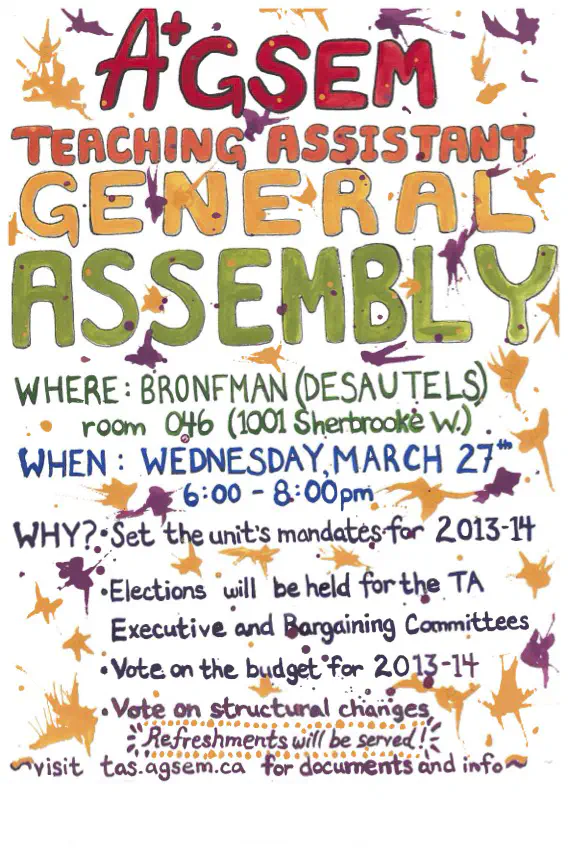
AGSEM General Assembly Poster (2013). AGSEM Archives, Vol. 4.1 “TA GA Poster.”
“From September 1 to December 1, 2011, non-academic and non-managerial staff represented by the MUNACA union were on strike at McGill. Their primary demands were for pay parity and a say in changes made to pension and benefit policies. In fact, unilateral changes had been made to the pension and benefits plans by the senior administration of McGill, some of which impacted the professoriate and other non-unionized workers at McGill as well. A small but relatively visible ad hoc faculty solidarity network, MFLAG (McGill Faculty Labour Action Group), emerged to support striking MUNACA workers. The type and level of involvement varied from writing statements in support of the union’s demands, to arranging for food and coffee for striking workers, to refusing to cross the picket line (thus losing a semester’s salary). The professors who would later organize support for student activists were among the most active contributors to MFLAG. Some of these professors had additional experience in solidarity organizing with students through two campus-community organizations, QPIRG-McGill (the Québec Public Interest Research Group) and CKUT (McGill’s campus-community radio station). These organizations have long served as nexuses for fostering ongoing student-staff-faculty-community solidarity.”
—Adrienne Hurley, “In Anticipation of an Unleashed Professoriate,” This is Fucking Class War: Voices from the 2012 Québec Student Strike, p. 249.

“Free Education Now!!!” Mobilization Poster by Megan Mericle (2013). AGSEM Archives, Vol. 4.1 “TA GA Poster.”
Continuing decades of activism and active participation in broader student and labour movements, AGSEM built bridges with other organizations. AGSEM participated in the annual conferences of the Coalition of Graduate of Employee Unions (CGEU), and from July 31-August 2, 2014 was the host of over 60 delegates from graduate student labour unions across North America. AGSEM also marched in support of Quebec’s great student uprising of 2012. Through these fights, AGSEM remained committed to the principle that an injury to one is an injury to all.

“Toronto TAs on Strike! Dare to Compare Contracts?” (n. d.) AGSEM Archives, Vol. 4.1 “TA Strikes Flyers.”
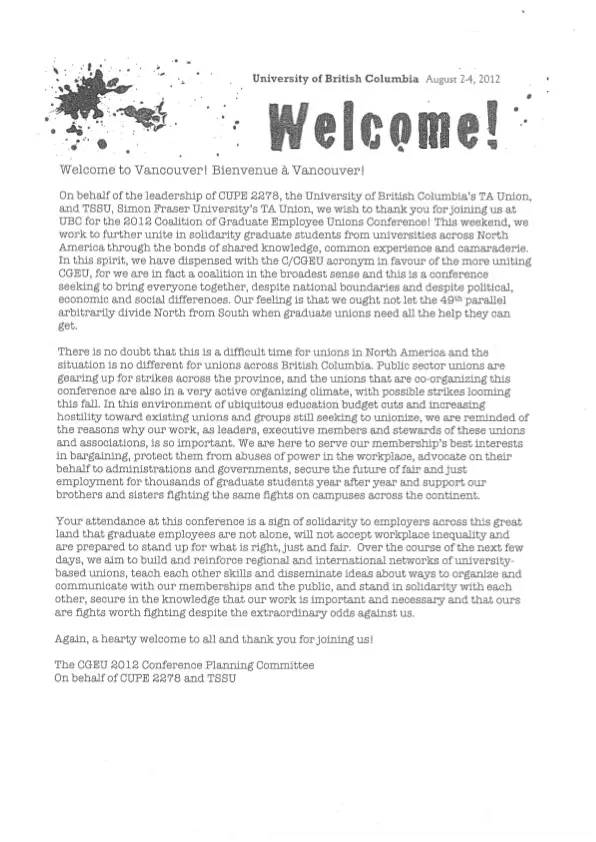
CGEU Conference Welcome Flyer (2012). AGSEM Archives, Vol. 5.2 “CGEU Conference 2012.”
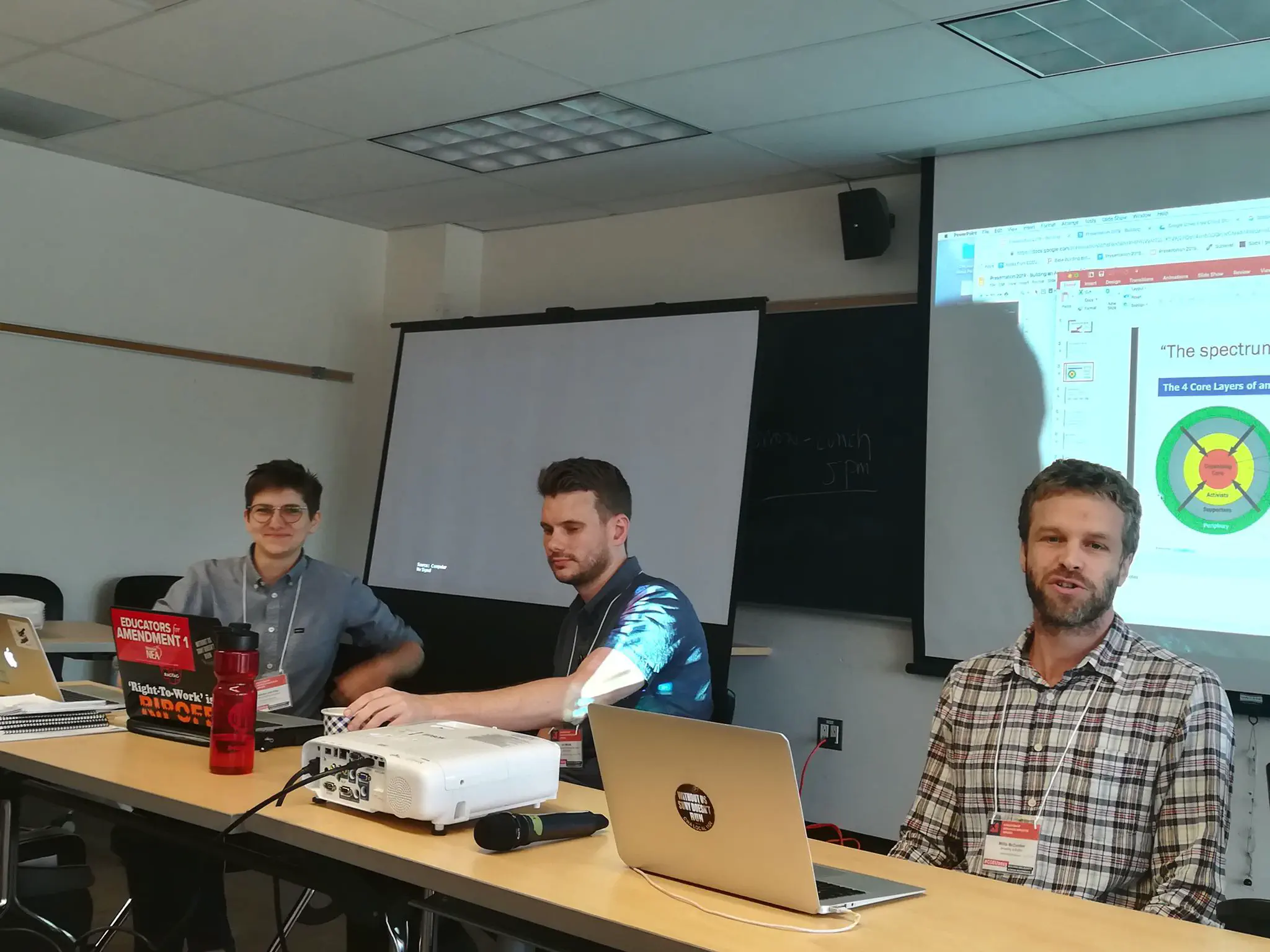
Kiersten van Vliet, AGSEM President (2018-19) presents at the annual CGEU Conference in Toronto, Ontario (August 14-18, 2019).
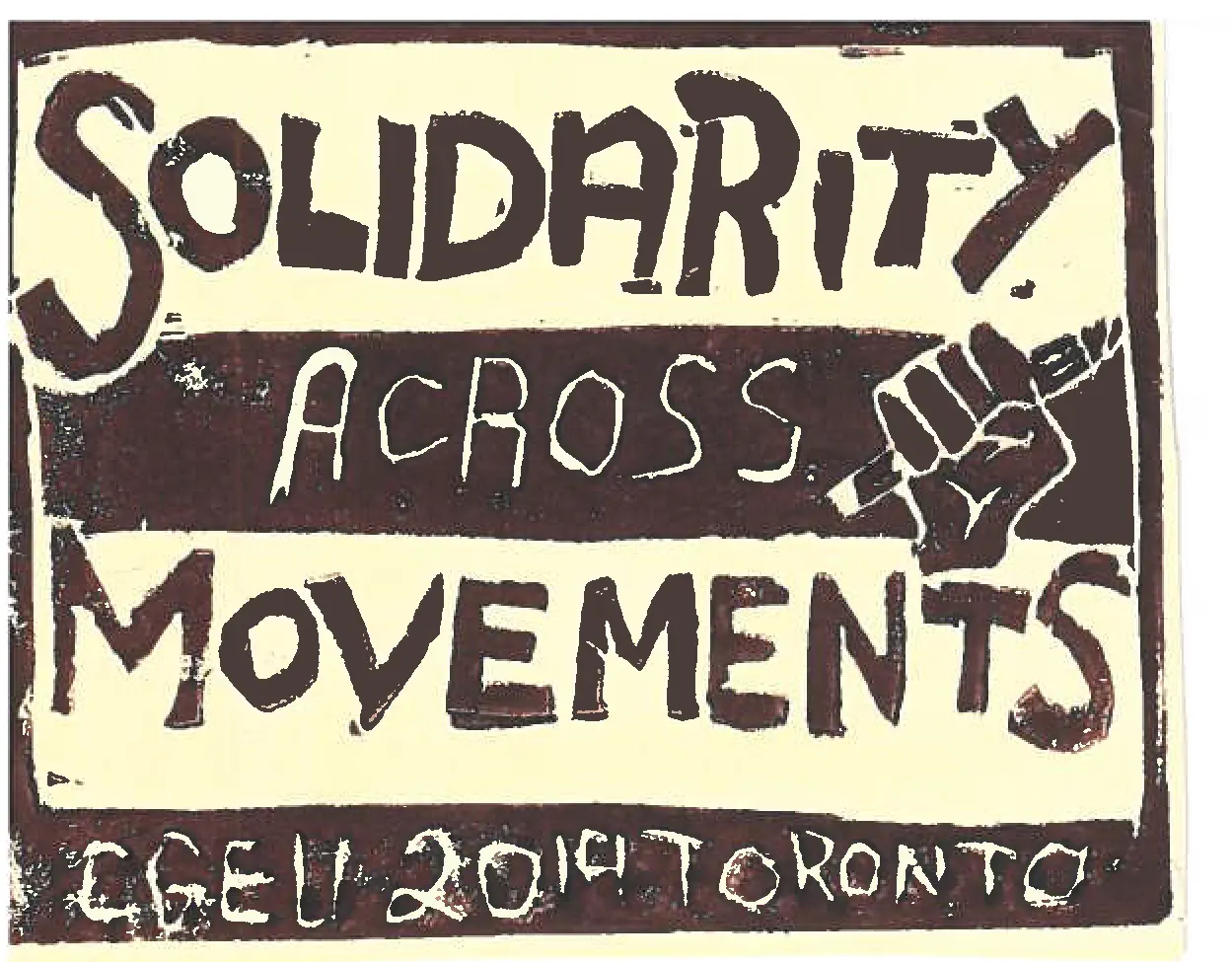
CGEU Toronto Conference Sticker (2019).
